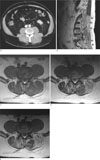Abstract
Acute rhabdomyolysis corresponds to the destruction of striated muscles causing the release of their cellular contents into the plasma and circulation. It could be caused by alcohol abuse, drug abuse, infection, trauma, exertional exercise, and coma. Rhabdomyolysis associcated with surgery is rare, however, we present a case of bilateral paraspinal rhadomyolysis after a prostatectomy in the supine position.
Figures and Tables
Fig. 1
A 62-year-old man with lower back pain following prostatectomy.
A. Enhanced CT scan shows swollen bilateral paraspinal muscles with heterogeneous enhancement.
B. Sagittal T2WI shows high signal intense lesion (arrows) in the paraspinal muscle from L1 level to sacral level.
C. Axial T1WI shows swollen bilateral erector spinae muscles, especially left one, with intermediate to high signal intensity.
D. Axial T2WI shows heterogenous high signal intense lesion in the bilateral erector spinae muscles.
E. Gadolinium enhanced axial T1WI shows heterogenous enhancement in the bilateral erector spinae muscles.

References
1. Vonholder R, Sever MS, Erek E, Lameire N. Rhabdomyolysis. J Am Soc Nephrol. 2000; 11:1553–1561.
2. Ferreira J, Galle C, Aminian A, Michel P, Guyot S, Wilde JP, et al. Lumbar paraspinal rhabdomyolysis and compartment syndrome after abdominal aortic aneurysmrepair. J Vasc Surg. 2003; 37:198–201.
3. Jung KC, Kwon ST, Cho KH, Kang SK, Kim JM. MR Findings of Acute Rhabdomyolysis: Case Report. J Korean Radiol Soc. 2003; 49:119–123.
4. Glassman DT, Merriam WG, Trabulsi EJ, Byrne D, Gomella L. Rhabdomyolysis after laparoscopic nephrectomy. JSLS. 2007; 11:432–437.
5. Lee JH, Yoon YS, Park IC, Kim SH. Rhabdomyolysis due to Sunburn. J Korean Soc Emerg Med. 2003; 14:455–457.
6. Lappalainen H, Tiula E, Uotila L. Elimination kinetics of myoglobin and creatine kinase in rhabdomyolysis: implications for followup. Crit Care Med. 2002; 30:2212–2215.
7. Sava J, Moelleken A, Waxman K. Cardiac arrest caused by reperfusion injury after lumbar paraspinal compartment syndrome. J Trauma. 1999; 46:196–197.
8. Osamura N, Takahashi K, Endo M, Kurumaya H, Shima I. Lumbar paraspinal myonecrosis after abdominal vascular surgery: a case report. Spine. 2000; 25:1852–1854.
9. Stock KW, Helwig A. MRI of acute exertional rhabdomyolysis--in the paraspinal compartment. J Comput Assist Tomogr. 1996; 20:834–836.




 PDF
PDF ePub
ePub Citation
Citation Print
Print


 XML Download
XML Download